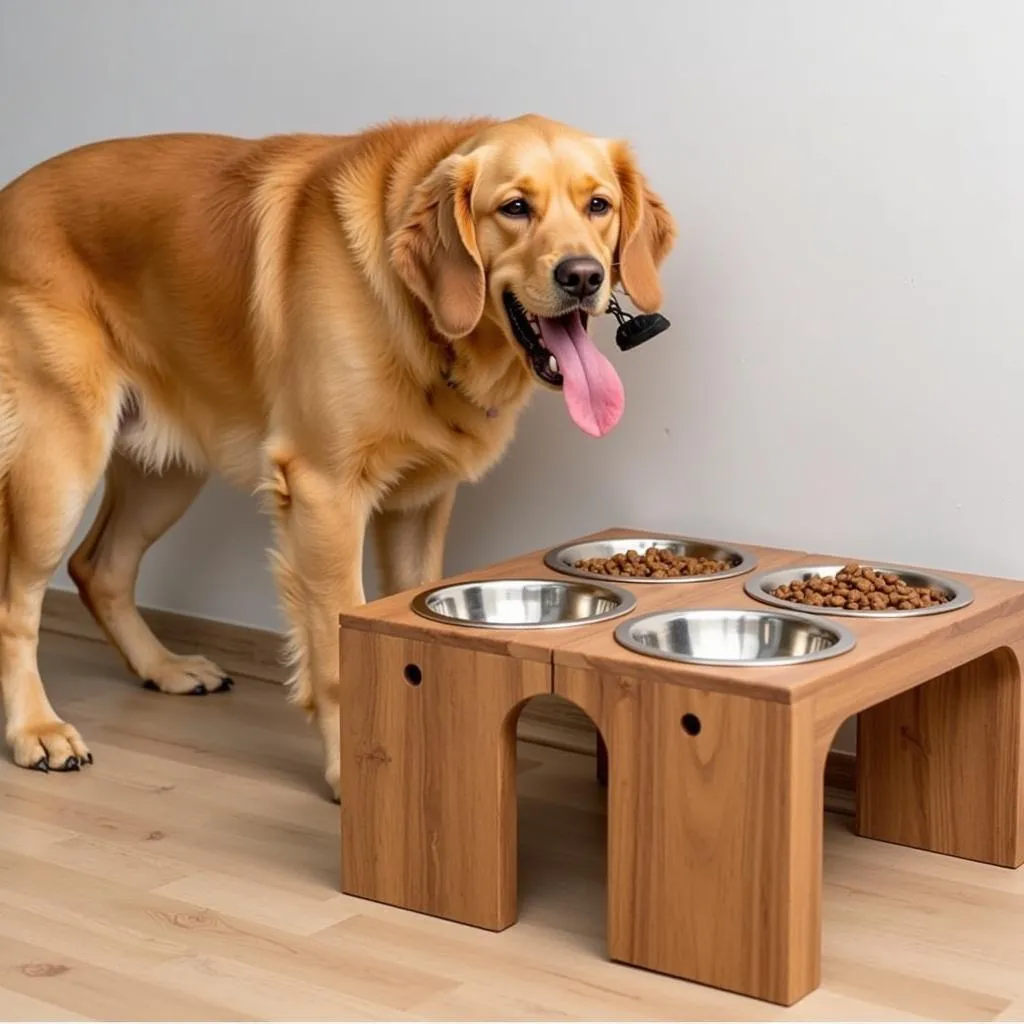Dog Food Feeders have quickly gone from a novelty to a must-have for many pet owners. But with so many types available, choosing the best dog food feeder for your furry friend can feel overwhelming. That’s where we come in! This guide covers everything you need to know about dog food feeders, from the different types and their benefits to choosing the perfect one for your canine companion.
Why Consider a Dog Food Feeder?
 Dog enjoying a meal from an elevated feeder
Dog enjoying a meal from an elevated feeder
Beyond convenience, dog food feeders offer a range of benefits for both you and your pet. Here are some key advantages:
- Regulated Portions: Say goodbye to overfeeding! Many feeders allow you to set specific portion sizes, helping you manage your dog’s weight and prevent obesity.
- Consistent Feeding Schedule: Automatic feeders ensure your dog is fed on time, even when you’re away. This is especially helpful for busy pet parents or those with irregular schedules.
- Slow Down Speedy Eaters: If your dog tends to gulp down food, a slow feeder bowl can help pace their eating, preventing bloat and indigestion.
- Improved Digestion: Elevated feeders can improve digestion by allowing dogs to maintain a more natural eating posture. This can be especially beneficial for senior dogs or those with certain medical conditions.
Types of Dog Food Feeders
Dog food feeders come in a variety of shapes and sizes to cater to different needs and preferences. Let’s explore the most popular types:
1. Automatic Feeders
 Automatic dog food feeder with a timer
Automatic dog food feeder with a timer
Ideal for busy pet owners, automatic feeders dispense pre-portioned meals at set times. They typically run on batteries or electricity and offer features like programmable timers, voice recording options, and portion control settings.
2. Gravity Feeders
Gravity feeders are a simple yet effective option for dry food. As your dog eats, gravity automatically refills the bowl from a larger reservoir. This type is perfect for ensuring a constant supply of food, especially for multi-dog households.
3. Slow Feeders
 Dog eating from a slow feeder bowl
Dog eating from a slow feeder bowl
If your furry friend inhales their meals, a slow feeder bowl can help! These bowls feature ridges, mazes, or other obstacles that force dogs to slow down and work for their food, promoting proper digestion and preventing bloat.
4. Elevated Feeders
Elevated feeders feature raised bowls, typically on a stand. This type of feeder allows dogs to eat in a more natural, comfortable posture, easing strain on their neck and joints. They’re particularly beneficial for large breed dogs and senior dogs.
Choosing the Right Dog Food Feeder
With so many choices, selecting the best dog food feeder for your furry companion depends on your individual needs and your dog’s eating habits. Consider these factors:
- Your Dog’s Eating Style: Does your dog eat quickly? An automatic feeder or slow feeder might be a good choice. If they graze throughout the day, a gravity feeder could be a better fit.
- Your Lifestyle: Are you often away from home? An automatic feeder can help maintain a consistent feeding schedule.
- Your Dog’s Size and Breed: Choose a feeder that’s appropriately sized for your dog. Larger breeds might benefit from an elevated feeder.
- Your Budget: Feeders range in price, so determine what features are most important to you.
Conclusion
Dog food feeders can significantly improve your dog’s mealtime experience while providing peace of mind for pet parents. Whether you’re looking to regulate portions, slow down a speedy eater, or simply make feeding time more convenient, there’s a perfect feeder out there for every dog and every owner.
Do you have any experience using dog food feeders? Share your thoughts and tips in the comments below!
FAQs about Dog Food Feeders
1. Are automatic feeders suitable for all types of dog food?
Most automatic feeders are designed for dry food. However, some models accommodate wet food with special compartments or attachments.
2. How often do I need to clean my dog’s food feeder?
Regular cleaning is crucial to prevent bacteria growth. Aim to wash your dog’s food feeder with soap and water at least once a week.
3. Can slow feeder bowls help with weight management?
Yes, by slowing down eating, slow feeder bowls can help dogs feel fuller for longer, potentially aiding in weight management.
4. Are elevated feeders suitable for puppies?
While elevated feeders can be helpful for some puppies, it’s best to consult with your veterinarian to determine the best option for your puppy’s age and breed.
5. Can I use a gravity feeder for wet food?
Gravity feeders are not recommended for wet food, as it can spoil quickly and create a mess.
Get in Touch
Need help finding the perfect dog food feeder for your furry friend? Contact us! Our team is here to assist you 24/7. Call us at 02437655121, email us at minacones@gmail.com, or visit our store at 3PGH+8R9, ĐT70A, thôn Trung, Bắc Từ Liêm, Hà Nội, Việt Nam. We’re always happy to help!